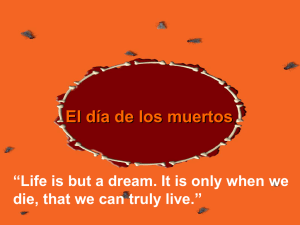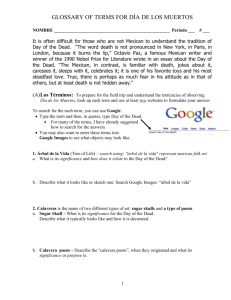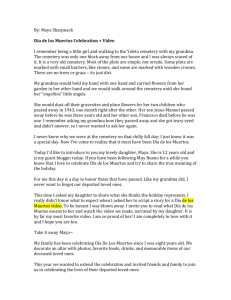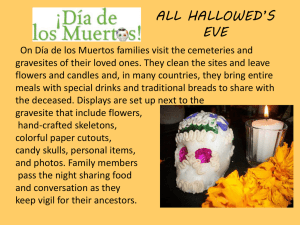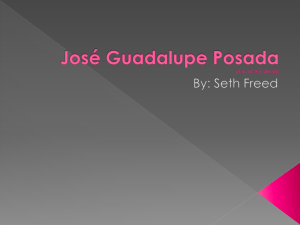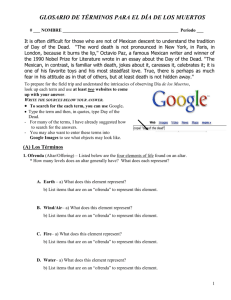El Dia de los Muertos The Day of the Dead
advertisement
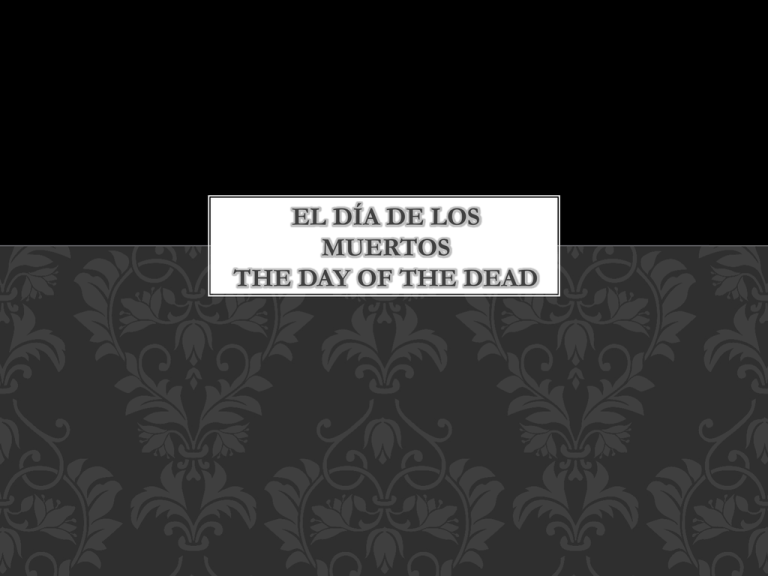
EL DÍA DE LOS MUERTOS THE DAY OF THE DEAD DIA DE LOS MUERTOS VIDEO How did the little girl feel at first in the Land of the Dead? -Scared, frightened, confused. What did the atmosphere of the Land of the Dead feel like? -Happy, cheerful, alive. Who was the skeleton that showed the little girl around the Land of the Dead? -Her mother Were you supposed to feel scared? THE HUFFINGTON POST “5 Dia De Los Muertos Questions You Were Too Afraid To Ask” Posted: 11/01/2013 8:20 am EDT Updated: 11/03/2013 11:20 am EST 5 DIA DE LOS MUERTOS QUESTIONS YOU WERE TOO AFRAID TO ASK THE HUFFINGTON POST POSTED: 11/01/2013 8:20 AM EDT UPDATED: 11/03/2013 11:20 AM EST WHAT’S THE DIFFERENCE BETWEEN DÍA DE LOS MUERTOS AND HALLOWEEN? Día de los Muertos -- also known as "Día de Muertos," or "Day of the Dead" in English -- is a holiday with Mexican origins that is celebrated on November 1 - 2. WHAT’S THE DIFFERENCE BETWEEN DÍA DE LOS MUERTOS AND HALLOWEEN? While some imagery might be close to that of Halloween, there are significant differences between the two. Día de los Muertos is a day to celebrate death -- or, more specifically, the deceased -- while on Halloween, death is seen as something to be feared. WHAT’S THE DIFFERENCE BETWEEN DÍA DE LOS MUERTOS AND HALLOWEEN? Día de los Muertos has both indigenous origins from the Aztec festival for Mictecacihuatl, The Lady of The Dead, and Catholic origins from the Spanish conquistadors’ All Saints and All Souls Day. WAIT, IT’S A TWO-DAY HOLIDAY? WAIT, IT’S A TWO-DAY HOLIDAY? Yes, the original Aztec holiday was actually a month long event, but when the Spanish conquistadores arrived and turned Mexico Catholic, the celebration became intertwined with All Saints Day (Nov. 1) and All Souls Day (Nov. 2). WAIT, IT’S A TWO-DAY HOLIDAY? Traditionally, Nov. 1 is when you welcome the souls of children that have passed away, known as Día de los Inocentes (Day of the Innocents) or Día de los Angelitos (Day of the Little Angels). Nov. 2 is when the adult souls arrive. HOW DO YOU CELEBRATE THE DEAD? HOW DO YOU CELEBRATE THE DEAD? Those who celebrate Día de los Muertos will usually put up altars honoring those members of the family who have passed away. HOW DO YOU CELEBRATE THE DEAD? They decorate the altars with candles, sugar skulls, marigolds, food, beverages and clothes. These offerings, or "ofrendas," are gifts for the dead and are usually a combination of his or her favorite things. HOW DO YOU CELEBRATE THE DEAD? HOW DO YOU CELEBRATE THE DEAD? Like the holiday itself, the altar also has mixed imagery of both indigenous and Catholic background. The graves of the deceased are also visited and honored with offerings as well as vigils. WOULD YOU HAVE TO GO TO MEXICO TO SEE THESE CELEBRATIONS? No, although Día de los Muertos is a Mexican National Holiday it is actually celebrated in other countries as well such as Guatemala, Brazil and Spain. It is also becoming more and more popular in the U.S. due to the large number of Mexican immigrants and Mexican Americans. WHAT’S UP WITH ALL THE SKULLS? WHAT’S UP WITH ALL THE SKULLS? Skulls are everywhere during Día de los Muertos. The origins trace back to the pre-Hispanic era, when they were kept as trophies and used during rituals. WHAT’S UP WITH ALL THE SKULLS? The most recognized skull on Dia de los Muertos is the Calavera Catrina. The image as we know it today originated with José Guadalupe Posada, a Mexican Artist who depicted a fancy female skeleton as a dig against the Europhile Mexican elite during the Porfirio Díaz dictatorship. It became an iconic image of the Mexican Revolution at the beginning of the twentieth century. WHAT’S UP WITH ALL THE SKULLS? But the actual Catrina is said to have originated thanks to the Aztec tale of Mictecacihuatl, the Lady of the Dead. 5 DIA DE LOS MUERTOS QUESTIONS YOU WERE TOO AFRAID TO ASK THE HUFFINGTON POST POSTED: 11/01/2013 8:20 AM EDT UPDATED: 11/03/2013 11:20 AM EST LA CATRINA La Calavera de la Catrina » José Guadalupe Posada (Mexican, 1852–1913) Intended as social satire, José Guadalupe Posada’s calaveras (images of skulls or animated skeletons) commented on the social and political lives of Mexicans in the late nineteenth and early twentieth centuries. LA CATRINA Although originally conceived by Posada’s contemporary Manuel Manilla, the calavera was popularized by Posada, whose cartoons circulated widely in newspapers, street gazettes, broadsides, and commercial posters. Perhaps the most famous of Posada’s calaveras is La Calavera de la Catrina, the skeleton of a high-society lady wearing a large, fancy hat. This figure, in particular, has become an icon of the Mexican Dia de los Muertos, or Day of the Dead. DIEGO RIVERA La Catrina as painted by Diego Rivera. This fifty foot fresco takes the viewer on a Sunday walk through Alameda Park, Mexico City's first city park that was built on the grounds of an ancient Aztec marketplace. SUENO DE UNA TARDE DOMINICAL EN LA ALEMEDA CENTRAL FRESCO 1947-1948 The large mural represents three principal eras of Mexican History: The Conquest, The Porfiriato Dictatorship, and The Revolution of 1910. SUENO DE UNA TARDE DOMINICAL EN LA ALEMEDA CENTRAL FRESCO 1947-1948 In chronological order starting from left to right we meet numerous prominent figures from Mexican history. In the center of the mural is Diego Rivera at the age of ten being led by the hand by the Dame Catrina ("La Calavera Catrina"), a skeleton figure parodying vanity created by the popular Mexican engraver Jose Guadalupe Posada. The well-dressed gentleman in a black suit and derby hat is Posada, who stands on the right of Dame Catrina and gallantly offers her his arm. Posada was highly respected by Rivera, who claimed him as one his artistic luminaries and teachers. SUENO DE UNA TARDE DOMINICAL EN LA ALEMEDA CENTRAL FRESCO 1947-1948 Posada's narrative style was an extremely influential model for Rivera's mural painting. Calavera Catrina, a symbol of the urban bourgeoisie at the turn of the nineteenth century must be taken here as an allusion to the Aztec Earth Mother Coatlicue, who is frequently represented with a skull. Coatlicue wears the plumed serpent, symbolic of her son Quertzalcoatl, around her neck as a boa. Her belt-buckle displays the Aztec astrological sign of Ollin, symbolizing perpetual motion. The adjacent figure is Frida Kahlo in a traditional Mexican dress holding in her left hand the Yin-Yang symbol of duality taken from Chinese philosophy, which also represents the duality from pre-Columbian mythology. Kahlo's other hand rest maternally on the shoulder of the young Diego, who sets out on his walk through life and through the world under her protection. DREAM OF A SUNDAY AFTERNOON IN ALAMEDA PARK SUENO DE UNA TARDE DOMINICAL EN LA ALEMEDA CENTRAL FRESCO 1947-1948 http://www.brownpride.com/history/history.asp?a=diegorivera/rivera_dream WORKS CITED http://www.brownpride.com/history/history.asp?a=diegorivera/rivera_dream 5 Dia De Los Muertos Questions You Were Too Afraid To Ask The Huffington Post Posted: 11/01/2013 8:20 am EDT Updated: 11/03/2013 11:20 am EST
